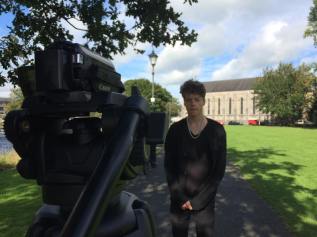Today we did the filming for our current project, which was to create a shootout – a well known sequence normally associated with classic westerns – which involved no weapons. Our short film is a standoff over a piece of money. Our filming was done with a handicam on a tripod, meaning we could get stable, level shots.
We had spent our week of planning figuring out the general style of western shootouts: the shot types they use, the order they put the shots in, the way it is edited together, the movements of the actors and the way the music fits in with the video. This meant that when it came to planning our shots out we had a template that we could follow. Because of our planning, we went down to our location with a written out plan of each shot that we needed, as well as a corresponding storyboard so that we could visualise it and match up our frames with the pictures. This was very helpful because it meant that as soon as we got down to the location we could set up the camera and start filming without too much hesitation, meaning our shoot was very efficient, as we wasted little of the time we had.
Our shoot was a learning process for us, and there were things things that we did on this shoot that we can take forward into other shoots. For example, we realised very early on that one version of each shot was not enough, and we ended up doing two or three of each one, each time just a tiny bit different. This was especially useful for the close up shots of the face, as it meant we could try out different things. We would get the person to frown a bit less, then a bit more, or we made them raise their head slowly, then quickly, so when it comes to editing we can see which one fits better.
The shoot also made me realise that no matter how much you plan out what you are going to do, changes will always be made right up until the last minute, and sometimes mid shoot. Our original ending was that when they reach for the money, its gone and the final shot would be a third person walking away with the money. But as we started shooting and we realised how many shot we were getting, we were worried that we wouldn’t be able to fit everything in the time limit (60 seconds), so we came up with an alternate ending, where the video cuts out at both people picking up the money and all you hear is a ripping sound. We planned to film both endings and see which fit in. What this taught me is that it’s okay to experiment a bit and try things out, as long as you talk it over with your team first and all agree on it, because its much better to have too much film that can be edited down, than too little film that doesn’t fit the brief.
We did encounter some problems that we had to work around. Our main issue was the battery. During our shoot, the camera ran out of charge twice and in order to charge it, we had to walk back to the college and wait 40 minutes for it to recharge, which meant we had less time to get the shots we needed. This was something we had not considered during our planning. Luckily, we chose a location close to the college, but some of the other places we had looked at were much further away, and if we had gone there, most of our time would have been taken up with walking back and forth. This made us more aware of problems like this, meaning that for future films, we can plan our location around this problem. Either, we can always use locations close to the college, or we can take the charger with us and find a place near the location that will allow us to charge up the camera if necessary.
Another problem was that we were filming in a public place, and this meant there were a lot of people walking in the shot. This was a factor we had considered during our planning, and the park was the place with the least amount of people in it. When shooting in buildings, you can get permission to put up signs, warning others that there is filming going on and not to disturb. In open, public places, it is more difficult and the most we could do is try to not get in anyone’s way and always let people past.
Overall, I’d say the shoot was very successful, because we got all the shots we needed as well as some extra ones, and we used our time well so we got all the shooting done in a day despite the problem of the camera losing charge. I learnt that on a shoot it is always important to have a clearly laid out and thorough plan, but also to be flexible and open to exploring different ways of doing shots.



This is very good Kitty—well done. I’m especially pleased to see you discuss the improvisation of a new ending (which sounds much cleaner and funnier than your original ending) and the process of negotiating ideas with crewmates. I’m also pleased to see you shooting multiple versions of the same shot to give yourself options in the edit. This is excellent. It would be good to see you being a little more personally reflective in your evaluation—consider how this project has impacted on your individual understanding, rather than that of the group. But as a first evaluation, this is very strong.
LikeLike